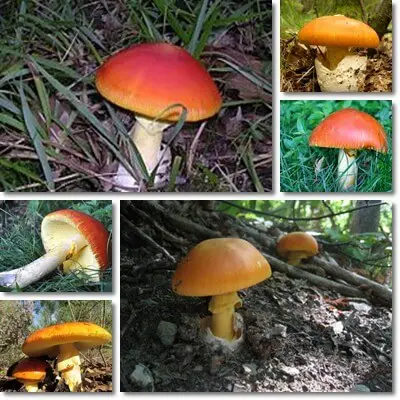The popular Amanita caesarea, best known as Caesar’s mushroom or the ovolo mushroom, is a species of edible mushroom from Europe and northern Africa. It is closely related to the poisonous death cap mushroom, Amanita phalloides, but its more particular appearance, notably bright red-orange colors, helps prevent confusion between the species. The nutrition of Amanita caesarea is poorly understood, but the species is cited as a good source of vitamin C and vitamin D2 as well as contains good amounts of dietary fiber. On the downside, it is known to accumulate heavy metals from the surrounding environment.
What does Caesar’s mushroom look like? The adult Amanita caesarea is a medium to large, red-orange mushroom with an otherwise typical appearance: a stalk supporting an umbrella-shaped cap. But it doesn’t look that way throughout its evolution. When the young mushroom breaks out of the ground, the red-orangey, smooth cap is egg-shaped and rests on a white-grey cup-like structure. As it matures, the stalk or stipe becomes visible and the cap spreads out, taking on an umbrella shape. In adult specimens, the stalk is slightly thicker at the base, smooth and pale yellow or golden yellow in color. The base of the stalk rests on a white-grey cup-like structure; the top of the stalk is surrounded by a ring-like structure of the same color as the stalk.

As the cap flattens, it develops fine, uniform ridges or striations along the margins, but remains smooth on top. The margins may tear, likely due to to loss of moisture. Elongated, pale yellow gills can be found underneath the cap. Amanita caesarea is colloquially known as a red mushroom due to its vibrant red and orange colors. Adult specimens retains the specific coloring: bright, red-orange cap with pale yellow or golden yellow stalk. Depending on age, Caesar’s mushroom specimens may be either a uniform orangey color or slightly redder in the center, fading to orange towards the margins.
Is Caesar’s mushroom, Amanita caesarea, poisonous? No, it isn’t. It’s actually an edible mushroom and perfectly safe for human consumption, in reasonable amounts, of course.
What does Caesar’s mushroom taste like? The species has a mild-tasting flesh with delicate nutty flavors and a meaty, slightly chewy texture. The flesh is quite tender. Overall, it tastes like a typical mushroom.
Caesar’s mushrooms can be used in pasta, salads, rice or risotto recipes, stews and can be grilled, baked, roasted, boiled or stir fried. They are also commonly eaten raw, thinly sliced and lightly dressed with olive oil or lemon juice or vinegar. They are often paired with other vegetables or used as stuffing for ravioli, tortellini or other Italian recipes. In Italy where they’re extremely popular, they are known as ‘ovoli funghi’.

Amanita caesarea look-alikes
There are many species of both edible and inedible look-alikes for Caesar’s mushroom. Find out below what are the 6 most likely species to mistake for A. caesarea:
1) Amanita muscaria, the fly amanita or fly agaric. It’s also commonly known as the false Caesar’s mushroom and is considered a poisonous specimen. The difference between Caesar’s mushroom and the fly agaric is the latter has small, white flakes on the reddish cap and a white, rather than yellowish stalk.
2) Amanita muscaria var. guessowii. Commonly known as the yellow fly agaric, it is the yellow version of the fly agaric mushroom. Is Amanita muscaria Guessowii edible? No, it’s not an edible mushroom. It’s actually considered poisonous. Compared to Amanita caesarea, both A. muscaria and A. muscaria guessowii have hallucinogenic properties, affecting brain function and altering perception, mood and behavior.
3) Amanita jacksonii, also known as the American Caesar mushroom or Jackson’s slender Caesar. It’s basically the equivalent species of Amanita caesarea in (eastern) North America. The Amanita jacksonii mushroom is a perfectly edible look-alike.
4) Amanita arkansana, or the Arkansas slender Caesar mushroom. Found in North America. It’s not only a look-alike, but also an edible substitute for A. caesarea.
5) Amanita hemibapha, or the half-died slender Caesar. Found throughout Asia. While it is edible, it has several inedible and poisonous look-alikes, so amateur foragers are advised to practice extreme caution when sourcing the fungi from the wild for consumption.
6) Amanita phalloides, commonly known as the death cap or, less frequently, the white amanita mushroom. It is an extremely toxic species, known to affect the liver and kidneys. Even one small mushroom can cause fatal liver and kidney damage. It resembles A. caesarea in appearance in terms of shape and size, but lacks the vibrant colors. Instead of bright orange-red, it’s white with pale yellowish or olive-green.
Nutritional information
There is little official information regarding the nutrition of Caesar’s mushrooms. Overall, the species is considered to have a typical mushroom nutrition, providing good amounts of dietary fiber but few calories. Other significant nutritional facts of Caesar’s mushrooms include good amounts of ascorbic acid (vitamin C) and ergosterol (vitamin D2 precursor). The presence of B vitamins, carotenoid antioxidants as precursors of vitamin A and various dietary minerals (calcium, copper, iron, magnesium, manganese, phosphorus, potassium and zinc) is inferred from knowledge of the nutritional content of mushrooms in general, although it’s likely some of these nutrients are only found in trace amounts.
So from a nutritional standpoint, Amanita caesarea stands out as a source of several essential nutrients, meaning it contributes to dietary requirements and has the potential to produce health benefits for the consumer. However, because studies show the species accumulates heavy metals from the surrounding environment (mushrooms typically do so), it is advised to keep to a modest intake to avoid side effects.
What are the benefits?
What are the benefits of Caesar’s mushrooms? Given current knowledge of the nutritional profile and other health-related properties of Amanita caesarea specimens, potential benefits associated with reasonable intakes may include:
1) Meeting dietary requirements of essential nutrients. In other words, eating Caesar’s mushrooms provides varying amounts of different essential vitamins and minerals and macronutrients and contributes to nutritional status, helping meet nutritional requirements.
2) Weight loss benefits. Caesar’s mushrooms can be considered for weight loss diets. Mushrooms in general are low in calories which makes them good foods to eat if you want to lose weight. In reasonable amounts, of course.
3) Antioxidant properties. The bright colors of Caesar’s mushrooms indicate the presence of pigmented antioxidants, likely in the form of carotenoids, some of which may hold vitamin A activity. Such antioxidants hold benefits for eyesight and skin in particular, but in order to be taken up by the body, the mushrooms are best consumed with a source of fat. For example: butter, olive oil, meat, eggs, dairy etc.
4) Benefits for digestion. As a plant food, Caesar’s mushrooms are a good source of dietary fiber, indigestible plant material that regulates digestion, optimizing transit time and relieving constipation.
5) Source of vitamin D. According to studies, Amanita caesarea is a source of vitamin D. More exactly, the species has been found to contain ergosterol, a precursor of vitamin D2 (also known as ergocalciferol). By contributing to meeting vitamin D requirements, Caesar’s mushrooms provide benefits for the immune system, female fertility in particular and optimize calcium, magnesium and phosphorus absorption for strong bones and teeth. Meeting vitamin D requirements holds benefits for pregnant women, reducing the risks of pre-eclampsia and diabetes in pregnancy.
6) Source of vitamin C. Studies have identified Caesar’s mushrooms as a source of ascorbic acid, or vitamin C. The essential nutrient is known to hold benefits for the immune function, anti-inflammatory and antioxidant activity and is responsible for collagen synthesis and subsequently the health of connective tissues as well as anti-aging benefits for the skin.
Study: Vitamin D and Sterol Composition of 10 Types of Mushrooms from Retail Suppliers in the United States. Katherine M. Phillips, David M. Ruggio, Ronald L. Horst, Bart Minor, Ryan R. Simon, Mary Jo Feeney, William C. Byrdwell, and David B. Haytowitz. Published in the Journal of Agricultural and Food Chemistry: 2011, 59 (14), 7841-7853.
Side effects and contraindications
1) May trigger allergic reactions. It’s not unlikely for mushrooms to trigger allergic reactions. Seek medical assistance immediately if you experience signs and symptoms such as: a rash or red, itchy bumps on the skin, difficulty breathing, wheezing, coughing, throat swelling or swelling of the lips or tongue, low blood pressure, lightheadedness and fainting.
2) Source of heavy metals. Amanita caesarea mushrooms have been found to accumulate heavy metals from the surrounding environment, including but not limited to cadmium and lead. Levels exceeded normal numbers which has lead to the recommendation to eat Caesar’s mushrooms reasonably (small amounts, preferably not every day). The species is contraindicated for small children.
3) Source of digestive discomfort. Gastrointestinal side effects are usually associated with excessive intakes and may include: general stomach upset, indigestion, loose stools or diarrhea.
Considerations
If you’ve eaten Caesar’s mushrooms you’ve foraged yourself and experience gastrointestinal discomfort or other side effects that are either severe or do not subside quickly but rather grow in intensity, it might be best to see a doctor as soon as possible. It’s fairly easy to mistake other related, look-alike and potentially toxic species of mushrooms for Amanita caesarea.
